
NEW YORK CITY - Perseverance, passion and a constant pursuit for culinary excellence are three characteristics that define renowned Peruvian chef and influencer, Rodrigo Fernandini. But before gathering over 1 million followers on Instagram, becoming viral several times with his signature signoff "buenazo!" cooking was not on his radar.
Fernandini grew up in Chiclayo, Peru, more than 400 miles from the capital city of Lima, but just off the Pacific coast of the country. Growing up so close to the sea, he remembers the smells of onions, garlic and fish wafting from his mom and grandma's kitchen. These experiences, he recalls, always made him keen to quality ingredients and well-made dishes.
Growing up, however, Fernandini did not consider cooking as a possible avenue for his success. In fact, he tried different careers before settling in. From business to law and even modeling, Fernandini, then a young man in his 20s, would give himself the space to try out different occupation options to dedicate the rest of his life to. None panned out.
"But one day I was sitting down in my bed and I had this amazing urge inside me to cook. It was different. It was like a fire inside me that needed to cook," he said in an interview with The Latin Times. "So I thought, 'you know what? Go for it. Try it out, see what happens."
Fernandini found his true calling in cooking. But his career was not necessarily easy.
He started by knocking on restaurants' doors, hoping one would take him in as an apprentice for free. One eventually did, and a two hour shift turned into a 12-hour rush.
"It was like the second I stepped in the kitchen, I fell in love. The rush, the adrenaline, the flight decks, the teamwork, the pressure," he said. "I felt like I found my spot."
Fernandini would eventually solidify his culinary education, attending Le Cordon Bleu in Lima, an prestigious network of hospitality and culinary schools.
He then moved to the U.S. to possibly get more opportunities. Not long after, COVID-19 came around, shutting down several of his possibilities. But Fernandini did not give up on his dreams, continuing to train in San Francisco in luxury hotels, restaurants and privately cooking for celebrities.
"Sometimes you need [bumps in the road] because those are the life lessons in life that you need to be prepared for what you are actually going to get," the chef reflects.
Now, having become a social media sensation, he travels back and forth between Florida and New York to attend his multiple restaurants, including Artesano (in TriBeCa, New York), and take care of his wife and son.
Fernandini sat down with the Latin Times to discuss his trajectory and passion for Peruvian food. This interview has been edited for length and clarity.
What do you think sets Peruvian food, and food from Chiclayo in particular, apart from the rest of the continent?
I love that question. I think that Peruvian cuisine is what it is today because we are very fortunate as Peruvians that during these 11,000 years of history we have had influences from different countries and cultures. So each culture brings their ingredients, their techniques, their influence, their celebrations, their holidays, their way of life.
When you add to the pile, new things are born. Like, for example, lomo saltado is one of the most classic, homey dishes in Peru. Of course it's a Peruvian dish. But if we think about it and we go a little back, it is the exact and perfect representation of Peruvian and Chinese fusion. The way we cook it in the wok with the fire, with the flame, with the soy sauce, with the ingredients. Just analyze the ingredients where they come from. And that's the beauty of cooking, right?
Then we have our tallarines verdes, which is basically a Peruvian pesto. But instead of parmesan cheese, we use queso fresco, and instead of only basil we use basil and spinach and aji amarillo.
I sometimes talk with my fellow countrymen and they are very proud. They say things like "oh but we shouldn't do things like this. We shouldn't change traditional recipes, we should respect the tradition.' And I'm like, bro, this dish is the way it is because our country came with techniques and ingredients and it was born. So we need to be grateful. We need to be open and inclusive with our culture.
Now, for example, we have Venezuelans in our country. Millions of them. They're getting married to Peruvians, which is amazing. My friend just got married with a beautiful Venezuelan girl, and they have a kid. So this kid is gonna grow up in a Peruvian-Venezuelan home. They're going to eat arepas and ceviche, and they're gonna start combining them, like, putting their lomos saltados inside their arepas for breakfast. And that's how new flavors and new combinations are born.
And I think that as cooks and as Peruvians, that's our mission; to develop, to try to propose, new techniques, new flavors, new combinations. And at the end, some of them will live forever.

How would you say that developing these recipes has helped you connect with your culture?
When I moved to the US, I was 26 years old. So obviously most of my life took place in Peru. All my traditions, my inspiration, the smells, the flavors, I learned there. My goal was, of course, to spread Peruvian cooking around the world, but there are amazing cuisines that are doing some crazy techniques. Modern. Very stylish. I want to combine both ideas.
And then I'm doing Peruvian food. So of course the Peruvian ingredient or the Peruvian influence has to be present, and you have to understand it by eating it, you can't be like "Oh, if you wouldn't say it I would have no idea." So you have to be the influence of the dish.
I like to tell the story. And also what we do in Artesano, for example, every dish we make has a story to tell. Sometimes we do it in a self-explanatory, traditional way, like in the lunch menu, a lomo saltado. But sometimes we just create a beautiful couple dishes. We have created a pasta with seven colors, like the mountain of Cusco. It is obviously a super technique-oriented, hard to elaborate dish. But it's amazing that somebody foreign shows up to the restaurant and sees this pasta looks like a rainbow. And you're able to talk about it like "This is inspiration. There is a mountain in Peru, 5000 square meters above sea level, 100 km south east of Cusco. We wanted to represent the story, the tradition, respecting the ingredients that we consume in that region of Peru."
That's what we do in Artesano. We tell a story and we take you around Peru one bite a time.

Speaking of Peru, what's your favorite dish from your country?
Ceviche. I can eat ceviche every day of my life.
Your videos constantly go viral across social media platforms, and you've become some sort of Peruvian culinary icon. Do you consider social media to be an integral part of your career as a chef?
I would say so, for sure. One of my greatest passions is teaching. I love to teach. So one day I said, why not combine it? I did some acting when I was younger, so I feel very comfortable in front of a camera, giving speeches or talking in public. Performing gives me even more energy, for some reason. So, combining this, with teaching that is something that I love, which is cooking with my own style, has given me the opportunity to do this— be in social media. And I think that is a great way to connect with people that, for example, can not go meet me in my restaurant because obviously it's a little far away and don't have the access to come.
I also use my channel as a way of inspiring people, especially young cooks, but also not necessarily people who want to be in the food industry. There is a path for everybody, you have to be consistent, you have to be responsible, you have to keep going, you have to put your mind to it. Some people think I'm annoying, some people think I'm amazing, and that's good. I don't care. If I can inspire one person, my mission is complete, that's what I want. And I think so far we're doing a good job.
Social media is also helping me to spend a little more time with my family, which is something that if you had asked me ten years ago as a chef, I would have told you it's impossible because how am I supposed to make money or cook if I'm not inside a kitchen, right? But with technology, with social media I can do that.
As Latin American food gets more popular across the world, what do you hope to see more of in the future?
I just think that we should continue on the same path. I think South America and Central America have so much story to offer that people are starting to see it through social media. It is easier to want to see Costa Rican food, and then you go online and you have 30 guys making Costa Rican recipes, and you go "oh my God, I never thought about the combination."
I think Latin cuisine right now, as you said, is getting a very important and solid place in the culinary world. And I think it is just a matter of time until we start to see more Michelin star restaurants in America and Europe and hopefully a Michelin guide in South America shortly. I'm sure that we have amazing restaurants that will be at the level that they are looking for. That will also help the economy of a country because when you have that available, people will make travels only just to eat at those restaurants. So I think that everybody will win.
© 2024 Latin Times. All rights reserved. Do not reproduce without permission.







